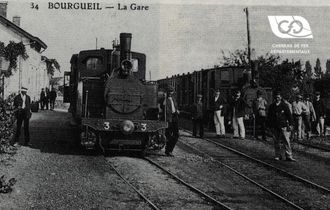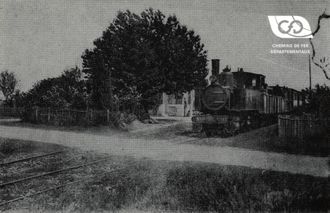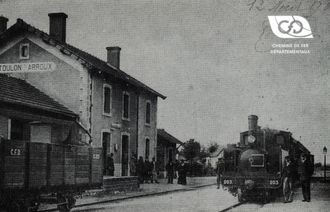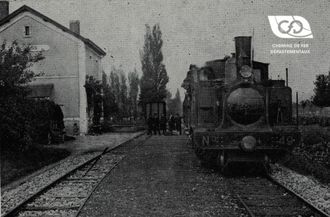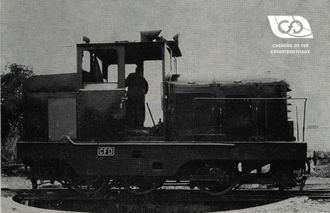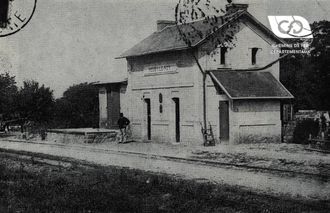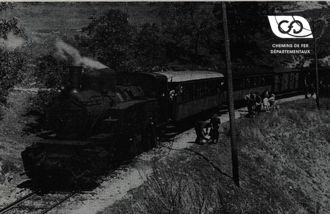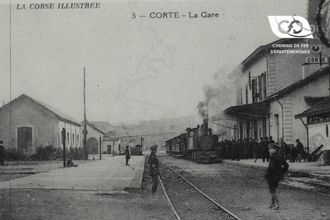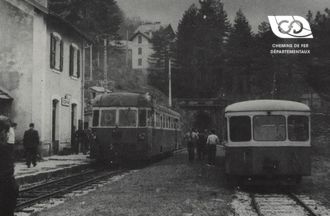This is the conclusion of S.N.C.F. Chief Engineer Ch. Tourneur on the suitability of the diesel locomotive to provide the various services required in railway operations.
A favourable response
The answer to can be as long as the service is moderate speed service, i.e. in which the diesel locomotive's still relatively low power-to-weight ratio is not a very unfavourable factor, because the power is developed at the rim with great effort, which requires precisely a relatively heavy locomotive. This is the case for shunting services, freight services on short lines where passenger services are entrusted to railcars, and service on many African and Far Eastern networks. However, on some narrow-gauge networks, the maximum axle load may be as low as 10 or 11 tons, and difficulties begin to arise if the power required exceeds 1,000 horsepower.
Standard track networks
In the case of normal track networks, line service on major arteries requires high powers. In Europe, modern steam locomotives routinely develop 2500 hp at the rim in sustained operation; on some foreign networks, particularly in America, the power requirements significantly exceed this figure. Even taking into account the greater flexibility of the diesel locomotive in certain respects, and in particular its superiority in starting up, it can therefore be seen that services on the main lines require locomotives developing a power on the diesel shaft which, for Europe, should not be less than 2500/3000 hp. On the other hand, the track layout is such that, while axles loaded to 18/20 t are acceptable on many European lines, limitations of 15 t, and sometimes less, are imposed on some branch lines. The American networks are almost alone in accepting much higher loads of up to 30 t per axle, and this factor has not been one of the least important in the development of diesel traction in the United States. For passenger services, we have just seen that the problem is complicated by the obligation to provide heating for the cars.
However, according to the current state of the art and with the axle loads allowed in Europe, the power of a diesel unit can hardly exceed 2000 HP. In the United States, the most common diesel units with a single engine are around 1900 hp, and express machines with two engines reach 2500 hp. The latter power is also obtained with a single engine, but on units with axles loaded to almost 30 tons.
A possible increase in power-to-weight ratio
However, the constant progress made by diesel engine manufacturers, in particular by increasing the supercharging rate of four-stroke engines, suggests that could lead to a further significant increase in power-to-weight ratio. However, it would be premature to conclude from this that, for Europe, the advent of the single-engine diesel locomotive of 2500 hp and more is close, because of the problems, still unresolved, of transmitting such power to the axles over a wide range of speeds, whatever the system adopted, whether mechanical, hydraulic or electric.
An example solution from America
In any case, it is still possible to use, following the example of America, the multiple-unit approach, but this solution is generally only economical if it remains exceptional; this is, moreover, what happens most often on most of the European lines where the new traction mode is developing, because highly loaded lines are electrified there.
If the regression of steam traction is a given, it is still impossible to assess how the division will be made between diesel and electric traction; but this will depend much less, we believe, on the possible performance of the diesel locomotive than on the two main economic factors influencing cost prices: maintenance expenditure and the respective prices of the two forms of energy used. The latter does not always depend, in many countries, on technical and economic contingencies alone; in other words, any prognosis would be hazardous.
| User Country | Constructor | Locomotive Designation | Year in Service | No. of Units. | Track gauge (m) | Max. speed (km/h) | Unit axle load (tons) | Diesel engine | Transmission type | Minimum continuous running speed at full power. (km/h) | Heating Boiler | Supply Weights | Total Weights All Including Tons | Total Weights Including Tons | |||||
| Type | Nbr | Nominal and total horsepower (HP) | Type | Nbr | Nominal and total horsepower (HP) | Type | Nbr | NbrNominal and total horsepower (HP) | Type | TypeNbr | NbrNbrNumber | ||||||||
| Germany GermanyBelgiumBelgiumBrazilDenmarkSpainUnited StatesUnited StatesUnited StatesUnited StatesFranceFranceGreat BritainGreat BritainGreat BritainNetherlandsSwitzerland French Union | Krauss Maffei Krauss Maffei CockerillAnglo-Franco-BelgianEsslingenNOHAB (Sweden)ALCOGeneral Motors Baldwin ALCOFairbanks MorseForges de la LoireBrissonneau and Lotz Forges de la LoireAlsthomBritish-RailwaysBritish-RailwaysBritish-RailwavsBritish-RailwaysAlsthom SLM-Winterthur Alsthom | B' B'(branch lines) B' B' B' (line)D (man?bo Bo (line)Co Co Co (line)C' C' (line)(AIA) (AIA) (line)Co Co Co (line)(AIA) (AIA) (line)Co Co (line)(AIA) (AIA) type E9(passenger)Bo Bo Bo type AS 16(freight)Co Co Co type DL 600Bo Bo type H. 20.44C (shunting)Bo Bo Bo Bo (shunting and branch lines)Co Co Co (transfer)Co Co Co (league)C (man?co Co Co (line)(l'Co) (Col') (line)Bo Bo Bo (secondary lines) Co Co Co (man...) Co Co Co (line)(l'Co) (Col') (line)Bo Bo Bo (secondary lines) Co Co Co (man...) (line)Bo Bo (line)Bo Bo (secondary lines) Co Co (man...)works and transfer)Bo Bo (line) | 1952 19531955195519551954195419541954 19501953 1955195619531948195319531954 1955 1949 | 10 52155402341 48128 20152521(6)130 4 56 | 1,435 1,4351,4351,4351,43511,4351,6761,435 1,435 1,4351,4351,4351,4351,4351,4351,4351,4351,435 1 | 100 1405012012080133105158 113 1271136080 751303212514580 75 70 | 16 19.5.2021.7 13.21817.1625 27.5 29.528.217.617 201716.620.318.515 18.1 12.7 | (Maybach MD 650 or Daimler 820 or MAN 12 V 17.5/21)SEM 6 B 3 S Cockerili Baldwin 608 A General Motors 567 C MAN.W8V 22/30 General Motors 567-B ALCO EMD Baldwin ALCO Fairbanks-Morse Sulzer 6 I.DA 22 Sulzer 6 LDA 22 B Sulzer 12 I.DA 28 MGO.12Vl.SHR English-Electric 6 KT English-Electric 16 VT English-Electric 16 SVT/11MGO.12 SHR Sulzer 6 LDA 25 Sulzer 6 LDA 25 | 1 21112112 1 1111 121111 2 1 | 800/1000 2000750175017201920165017002550 1750 24501800510600 1900180040516222028850 1500 655 | {d} (HydraulicMaybach orVoith)Hydraulic VoithElectr. ACECElectr. EMDHydraulics VoithElectricElectr. EMD Electr. Westinghouse Electr. AGECElectr. WestinghouseElectr. CEMElectr. Brissonneau Electr. CEMElectr. AlsthomElectriqueElectriqueElectr. Alsthom Electr. BBC Electr. Alsthom | 13/19 1962022 19 16 152111 (3)12.7 2225 16.5(18 with2 word.9) with1 word.)21 | YesYesYesNoYesYesNoYesYesNoYesNoNoYesYesNo No No | 5,35 8,24,68,58 9,4613 6 7,52,72,8 6,328,2 7,310,163,83 4,09 3 | 64 (1) 72/78 (2)808710879,298,6103150 110 17711353 (4)68 (5) 1201025012213560 (7) 109 51 |
(1) Including 4 t of ballast.
(2) Depending on the type of engine and transmission.
(3) 5 km/h with truck.
(4 ) Including 2.6 t of ballast.
(5) Including 2.75 t of ballast.
(6) Only two other prototypes of 1760 hp etc. entered service in 1951.
(7) Including 4 t of ballast.
source : Excerpt from the article L'EVOLUTION DE LA LOCOMOTIVE DIESEL by Ch. TOURNEUR, Chief Engineer at the S. N. C. F. appeared in the Revue Universelle de Mines July 55





